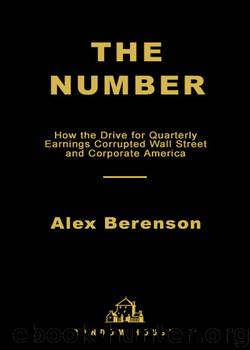The Number by Alex Berenson

Author:Alex Berenson
Language: eng
Format: epub
Tags: Nonfiction
ISBN: 9781588362889
Publisher: Random House Publishing Group
Published: 2003-03-03T16:00:00+00:00
* * *
From the beginning, the S.E.C.’s reach had exceeded its grasp, as Joel Seligman noted in The Transformation of Wall Street, his 1982 history of the commission. But the two-decade-long bull market had not merely strained the agency’s resources; it had taxed them beyond the breaking point.
Between 1980 and 2000, trading volume grew thirtyfold; money raised in new initial public offerings rose from $1.4 billion to $61 billion. The mutual fund industry, also under the jurisdiction of the commission, exploded from $46 billion to $5.1 trillion. Accounting became significantly more complex. The Nasdaq stock market and other electronic networks grew into important trading venues. By 2001, the S.E.C. was responsible for “700,000 registered representatives [brokers], over 5,000 investment companies, and 7,400 registered investment advisers . . . [and] 14,000 companies that have issued securities,” the General Accounting Office, the investigative arm of Congress, said in a 2002 report.2
Yet the commission’s staff had not grown much since 1980—or 1939. That year, when 260 million shares traded on the New York Stock Exchange, the agency had seventeen hundred employees. In 2001, when 2 billion shares a day changed hands on the Big Board and the Nasdaq, the agency had the equivalent of 2,936 full-time workers. Making matters worse, the commission’s staff had become increasingly green as the 1990s progressed. More than 30 percent of the commission’s employees quit between 1998 and 2000. Among professionals, turnover was even higher. By 1999, lawyers worked at the agency for an average of only 2.5 years before quitting, down from 3.4 in 1992. One-third of the branch chiefs in the Division of Enforcement, which brought fraud cases, had been in their jobs for less than a year.3
It wasn’t hard to figure out why the commission could not hold on to workers. Eighty-seven percent of all employees said they were dissatisfied with their pay compared to the private sector. No other issue came close. Of course, government employees had always made less money than their business counterparts, in return for better job security and shorter hours. But by the 1990s the gap between private and public salaries had become almost untenable, especially for the lawyers and accountants the commission needed to prosecute complex securities frauds. In 2000, first-year associates at major law firms in New York and Washington earned well over $100,000, more than senior S.E.C. lawyers. A third-year attorney at the agency could easily double or even triple his pay by jumping to the private sector. To cover the gap, the commission tried to use retention grants and special bonuses, but the meager size of those awards showed just how little money the agency had. In 1999, the commission’s average performance bonus was $1,600, compared to the Christmas bonuses of $20,000 or more that top law firms offered their first-year associates.4
As the agency’s employees were acutely aware, their salaries even lagged those of other government financial regulators. Bank regulators such as the Office of the Comptroller of the Currency were allowed to exceed the standard government salary scale to get qualified workers.
Download
This site does not store any files on its server. We only index and link to content provided by other sites. Please contact the content providers to delete copyright contents if any and email us, we'll remove relevant links or contents immediately.
| Biographies | Company Profiles |
| Economic History |
Pale Blue Dot by Carl Sagan(4907)
The Rules Do Not Apply by Ariel Levy(4842)
Goodbye Paradise(3724)
Ogilvy on Advertising by David Ogilvy(3503)
Liar's Poker by Michael Lewis(3367)
Delivering Happiness by Tony Hsieh(3363)
Into Thin Air by Jon Krakauer(3308)
Purple Cow by Seth Godin(3137)
Rogue Trader by Leeson Nick(2975)
The Social Psychology of Inequality by Unknown(2936)
The Airbnb Story by Leigh Gallagher(2797)
4 - Harry Potter and the Goblet of Fire by J.K. Rowling(2650)
The Mind Map Book by Tony Buzan(2510)
Bossypants by Tina Fey(2463)
Claridge's: The Cookbook by Nail Martyn & Erickson Meredith(2359)
All the President's Men by Carl Bernstein & Bob Woodward(2326)
Six Billion Shoppers by Porter Erisman(2267)
Master of the Game by Sidney Sheldon(2240)
Alibaba by Duncan Clark(2037)
